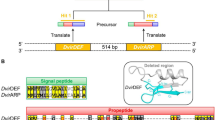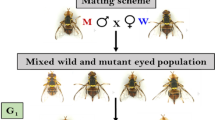Abstract
The allelic state of gene flamenco has been determined in a number of Drosophila melanogaster strains using the ovoD test. The presence of an active copy of gypsy in these strains was detected by restriction analysis. Then male reproduction behavior was studied in the strains carrying a mutation in gene flamenco. In these experiments mating success has been experimentally estimated in groups of flies. It has been demonstrated that the presence of mutant allele flam MS decreases male mating activity irrespective of the presence or absence of mutation white.The active copy of gypsy does not affect mating activity in the absence of the mutation in gene flamenco. Individual analysis has demonstrated that mutation flam MS results in characteristic changes in courtship: flam MS males exhibit a delay in the transition from the orientation stage to the vibration stage (the so-called vibration delay). The role of locus flamenco in the formation of male mating behavior in Drosophila is discussed.
Similar content being viewed by others
References
Terzian, C., Pelisson, A., and Bucheton, A., Evolution and Phylogeny of Insect Endogenous Retroviruses, BMC Evol. Biol., 2001, vol. 1, no. 1, p. 3.
Pantazidis, A., Labrador, M., and Fontdevila, A., The Retrotransposon Osvaldo from Drosophila buzzatii Displays All Structural Features of a Functional Retrovirus, Mol. Biol. Evol., 1999, vol. 16, no. 7, pp. 909-921.
Prud'homme, N., Gans, M., Masson, M., et al., Flamenco, a Gene Controlling the gypsy Retrovirus of Drosophila melanogaster, Genetics, 1995, vol. 139, pp. 697-711.
Kim, A., Terzian, C., Santamaria, P., et al., Retroviruses in Invertebrates: The gypsy Retrotransposon Is Apparently an Infectious Retrovirus of Drosophila melanogaster, Proc. Natl. Acad. Sci. USA, 1994, vol. 91, pp. 1285-1289.
Pelisson, A., Song, S.U., Prud'homme, N., et al., gypsy Transposition Correlates with the Production of a Retroviral Envelope-like Protein under the Tissue-Specific Control of the Drosophila flamenco Gene, EMBO J., 1994, vol. 13, pp. 4401-4411.
Subotcheva, E.A., Romanova, L.G., Romanova, N.I., and Kim, A.I., Several Specific Behavioral Features in Drosophila melanogaster Strains Carrying flamenco Mutations, Genetika (Moscow), 2001, vol. 37, no. 11, pp. 1272-1274.
Romanova, N.I., Subotcheva, E.A., Romanova, L.G., and Kim, A.I., A Study of the Capability of Associative Learning in Drosophila melanogaster Strains with the Mutant Gene Controlling Transposition of Mobile Element mdg4 (gypsy), Vestn. Mosk. Gos. Univ., Ser. 16: Biol., 1999, no. 2, pp. 16-18.
Romanova, L.G., Romanova, N.I., Subotcheva, E.A., and Kim, A.I., Mating Efficiency and Specific Features of Courtship Behavior in Drosophila melanogaster Strains with the Mutant flamenco Gene, Genetika (Moscow), 2000, vol. 36, no. 4, pp. 500-504.
Kim, A.I., Belyaeva, E.S., Larkina, Z.G., and Aslanyan, M.M., Genetic Instability and Transposition of Mobile Element gypsy in a Drosophila melanogaster Mutator Strain, Genetika (Moscow), 1989, vol. 25, no. 25, pp. 1747-1756.
Kim, A.I., Lyubomirskaya, N.V., Belayeva, E.S., et al., The Introduction of a Transpositionally Active Copy of Retrotransposon gypsy into the Stable Strain of Drosophila melanogaster Causes Genetic Instability, Mol. Gen. Genet., 1994, vol. 242, pp. 472-477.
Mevel-Ninio, M., Mariol, M.C., and Gans, M., Mobilization of the gypsy and copia Retrotransposons in Drosophila melanogaster Induces Reversion of the ovoD Dominant Female-Sterile Mutations: Molecular Analysis of Revertant Alleles, EMBO J., 1989, vol. 8, pp. 1549- 1558.
Dej, K.J., Gerasimova, T., Corces, V.G., and Boeke, J.D., A Hotspot for the Drosophila gypsy Retroelement in the ovo Locus, Nucleic Acids Res., 1998, vol. 26, no. 17, pp. 4019-4024.
Razorenova, O.V., Karpova, N.N., Smirnova, Yu.B., et al., Interstrain Distribution and Specific Structural Features of Two Subfamilies of the Drosophila melanogaster MDG4 (gypsy) Retrotransposon, Genetika (Moscow), 2001, vol. 37, no. 2, pp. 175-182.
Lakin, G.F., Biometriya (Biometry), Moscow: Vysshaya Shkola, 1990.
Siegel, R.W. and Hall, J.C., Conditioned Responses in Courtship Behavior of Normal and Mutant Drosophila, Proc. Natl. Acad. Sci. USA, 1979, vol. 76, pp. 3430- 3434.
Robert, V., Prud'homme, N., Kim, A., et al., Characterization of the flamenco Region of the Drosophila melanogaster Genome, Genetics, 2001, vol. 158, no. 2, pp. 701-713.
Author information
Authors and Affiliations
Rights and permissions
About this article
Cite this article
Subotcheva, E.A., Romanova, N.I., Karpova, N.N. et al. Male Reproduction Behavior in Drosophila melanogaster Strains with Different Alleles of the flamencoGene. Russian Journal of Genetics 39, 553–558 (2003). https://doi.org/10.1023/A:1023735717768
Issue Date:
DOI: https://doi.org/10.1023/A:1023735717768




